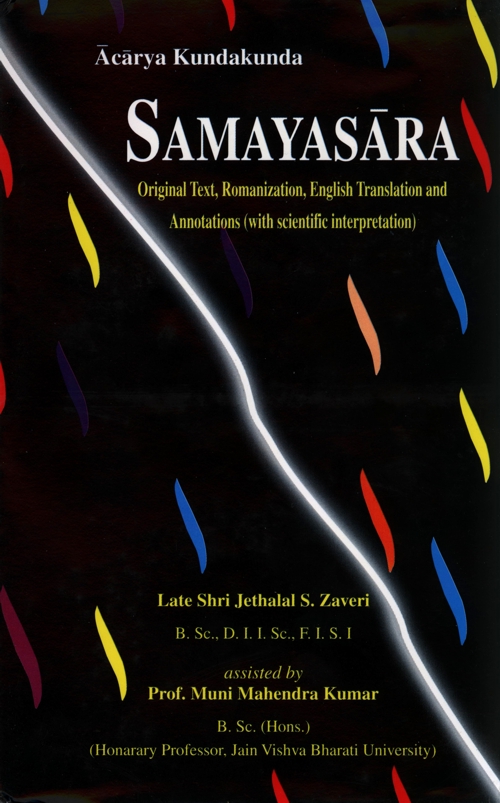"Nothing surpasses the excellence of Samayasāra—self-contained, self-determining, self-sufficient pure and perfect super SELF". These are the concluding words of the author and the gist of the 400 odd verses of the book Samayasāra.
In the preceding chapters the ultimate as well as the conventional nature of the nine padārthas (categories of truth) was revealed by discussing each of them from transcendental and empirical aspects respectively. Now in this concluding chapter, the central theme is totally pure knowledge—the purest unalienable attribute of the emancipated pure soul. All other padārthas, described from time to time, in the previous chapters are, in a way, relegated to a secondary position while purest knowledge—the all-embracing direct apprehension of the entire Reality—is given the primary importance. In fact, the all-knowing self in which the substratum and the attributes are fully unified, is the object of Self-realization. The other padārthas—auspicious and inauspicious karma, their influx, bondage, rise and demolition—fade away in the background as the soul has always been aware of them, bit never an active participant.
Earlier, we had discussed the delusion—the fundamental factor—which is the ultimate condition of the worldly state of existence of the soul. Jain philosophy is originally propounded by the omniscients. It basically aims at revealing the ultimate potentialities of the soul as directly apprehended by the omniscients. It also shows the pathway or the process which culminates in self-realization. The original twelve scriptures, called aṅgapraviṣṭa, comprise the entire truth about the nature of the self and self-realization that an omniscient can possibly express verbally. It is the duty of those highly gifted sages—śrutakevalῑs—who learn and fully comprehend the entire contents of these scriptures, to transfer this knowledge through canonical literature of various categories called, aṅgabāhya. Thus the pathway for self-realization is chalked out and made a public property, so that any one who cares to scrupulously follow the path may do so and realize the self.
The sources of knowledge other than the above—aṅgapraviṣṭa and aṅgabāhya—are unreliable and inadequate of the discovery of the ultimate truth as they may be vitiated by the limitations imposed by the senses and the intellect. Inevitably, they prescribe varying and conflicting concepts and courses which cannot all be true. The author of the present book, Ācārya Kundakunda, had, therefore, clarified at the beginning that the present work is the reiteration of what has been propounded by the śrutakevalῑ and not the original product of his own intellect. The basis of the pathway of self-realization, thus, is the pure and the perfect knowledge, unobscured and uncorrupted by the impurities of attachment and aversion.
Earlier, again, on more than one occasion, we discussed various facets of the non-absolutist attitude of the Jains. In this chapter also, the law of anekāntavāda is highlighted again and again. For instance, verses 10.14 to 10.58 discuss, in detail, the reality from both empirical and transcendental aspects. To some extent, this may be found to be repetition of different hypotheses of psycho-physical relationship, from various points of view.
This long chapter—the longest in the book, containing 108 verses—deals with a number of topics and can be divided into several sections:
- Verses 10.1 to 10.13 comprise a sort of appendix (culikā) to the subject matter of the preceding chapter—final liberation/ emancipation with particular emphasis on the nature and function of pure knowledge.
- Verses 10.14 to 10.20 jibe at Jain heretics (śramaṇa-bhāsas). Apparently about the time of Ācārya Kundakunda, some Jain thinkers and even ascetics must have developed leanings towards other philosophies—Sāṃkhya in particular. The author refutes their views regarding creation.
- In verses 10.21 to 10.37 the author refutes the false and self-contradictory beliefs of Sāṃkhya Darśana which is an absolutist philosophy and does not accept the non-absolutist doctrine of the Jains. In particular, Sāṃkhya puruṣa—equivalent to Jain soul—is eternally immutable and inactive, The learned author highlights the weakness of the argument which emphasizes only one aspect of reality exclusively and fail to explain concrete reality of the worldly state of existence.
- In verses 10.38 to 10.58, the false beliefs of another absolutist philosophy—Buddhists, are refuted. The author then explains through a simple analogy, the activity of the self, from both aspects. By another analogy, he proves that a substance cannot transfer its attributes to another in reality, though it may appear to do so.
- In verses 10.59 to 10.75, the author further discusses some eternal cosmic laws with particular reference to the inability of one substance to produce the attributes in another one, and concludes that infinite spiritual bliss transcends all sensuous pleasures.
- In verses 10.76 to 10.100, the nature and function of the pure knowledge is further elaborated, emphasizing that, while pure knowledge is identical to pure consciousness, it is quite different from the object of knowledge. The last few verses are also intended to rsfute the heretic doctrine that the soul is aṇṇamayu and koṣamaya.
- In verses 10.101 to 10.108, the inadequacy of various types of insignia and body-marks for self-realization is emphasized. In conclusion, the author says that realization of Samayasāra, the purest Super Self, is possible only through the adoption of transcendental aspect.
 Jethalal S. Zaveri
Jethalal S. Zaveri
 Prof. Muni Mahendra Kumar
Prof. Muni Mahendra Kumar

